
|
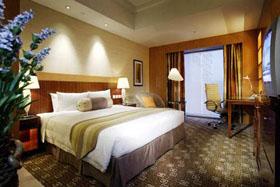
Our feature
hotel in Beijing -
Park Plaza in Downtown Wangfujing, Beijing
|
|
Beijing-Xi'an-Beijing 8 days 7 nights
Beijing and Xi'an probably has
one of the most cultural attractions of all of China.
Beijing, having 500 years, and Xi'an having 1500
years of history, these two cities are a must-see.
In Beijing, this tour will take
you to all major attractions no one can miss; including
the Great Wall, Ming Tombs, Tiananmen Square, Forbidden
City, the Summer Palace, and Temple of Heaven. We
will also take you to one of the biggest Silk Alley
to be able to purchase and view the great quality
Silk of China. The last portion of this tour will
also take you to the Beijing Zoo to be able to see
the Pandas.
And of course for Xi'an is the Terra Cotta Warriors. we will take you for a whole
day in Xi'an allowing you to spend much of your
time to observe the three pits. Following day we
will take you to the Big Wild Goose Pagoda.
See the 1500 years of culture and existence of Xi'an and
sink yourself into the past.
Highlights:
• Visit the Terracotta
Warriors, one of the world’s great
archaeological discoveries, as well as other
great sites in Xian, China’s ancient capital
• Experience the imperial lifestyle at the
Forbidden City, Temple of Heaven, the Ming
Tombs, and the Summer Palace, while also walking
on the Great Wall, while visiting Beijing,
China’s capital
• Your accommodation will all be in 4 star
hotels, and on the train ride you’ll travel in
luxury in the soft-sleeper compartment
Private Tour and Group Tour Packages Available
B=breakfast;
L=lunch; D=dinner Departure:
Upon booking
|
|
|
| |
STANDARD TOUR ITINERARY |
 |
Tour code:
P-BXB |
|
| DAY 01 |
Arrive in Beijing
Upon arrival at the Beijing airport, you
will be me by your local
English-speaking guide, and he will take
you to your hotel, the Tiantan Hotel, a
4 star hotel located in downtown
Beijing. If time permits, we can get
started with some sightseeing, but if
not, you are free to spend the night at
your own leisure, and resting up for the
days ahead.
|
|
| DAY 02 |
Great Wall Adventure (B, L)
At
7:00am you will be picked up at the
subway station nearest to your hotel by your
English-speaking guide and driver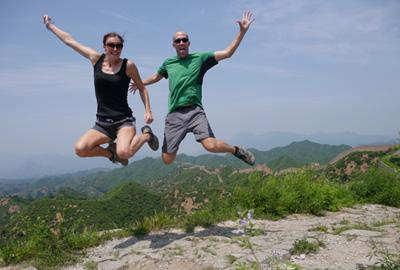 . From there we will make
the approximate 2.5 hour drive to the Great Wall at Jinshanling. The Great Wall at Jinshanling is one of the
best preserved parts of the Great Wall with many original
features. It got its name because it was built on the
Greater and Lesser Jinshan (�Gold Mountain�) Ranges. A
tablet with the Chinese inscription for Jinshanling Great
Wall was set into this section. The Jinshanling Great Wall
has not been repaired since 1570. It is a remote and
relatively isolated section of the Great Wall. As there are
relatively few tourists at Jinshanling Great Wall, it is a
good place to explore on foot. . From there we will make
the approximate 2.5 hour drive to the Great Wall at Jinshanling. The Great Wall at Jinshanling is one of the
best preserved parts of the Great Wall with many original
features. It got its name because it was built on the
Greater and Lesser Jinshan (�Gold Mountain�) Ranges. A
tablet with the Chinese inscription for Jinshanling Great
Wall was set into this section. The Jinshanling Great Wall
has not been repaired since 1570. It is a remote and
relatively isolated section of the Great Wall. As there are
relatively few tourists at Jinshanling Great Wall, it is a
good place to explore on foot.
The
Jinshanling Great Wall was initially built from 1368 to 1389
in the Ming Dynasty (1368-1644), and in 1567 and 1570
rebuilding of the Wall was mainly directed by General Qi
Jiguang (1528-1588). Poems and tablet writings can be found
on the Jinshanling Great Wall left from the time when Qi
Jiguang directed the rebuilding of this section of the Great
Wall. There are more than 100 watch towers along the
Jinshanling Great Wall. �Watching Beijing Tower� is on the
highest point, from which you can see Beijing. The
Jinshanling Great Wall is second only to the Badaling Great
Wall in its completeness.
You will then be dropped of at the hotel, and
the rest of the evening can be spent at your
discretion.
|
|
| DAY 03 |
Beijing–Xian (by train) (B, L)
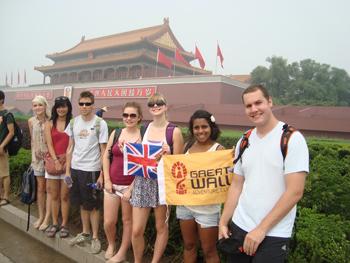 After breakfast in the hotel we will
head over to the center of Beijing,
Tiananmen Square. The largest public
square in the world, Tiananmen Square is
seen as China’s political center. Its
grounds have seen some turbulent
moments, from the May 4th Movement of
1919 to the political turmoil of 1989.
The south of the square is marked by the
Chairman Mao Memorial Hall, while the
center of the square is dominated by the
Monument to the People’s Heroes, an
imposing 10-story granite obelisk. To
the east is the National Museum of
China, and to the west is the Great Hall
of the People, home to China’s
legislative bodies. The north of the
square is dominated by the Gate of
Heavenly Peace, known for its iconic
portrait of Mao Zedong, and is the
national emblem of China. After breakfast in the hotel we will
head over to the center of Beijing,
Tiananmen Square. The largest public
square in the world, Tiananmen Square is
seen as China’s political center. Its
grounds have seen some turbulent
moments, from the May 4th Movement of
1919 to the political turmoil of 1989.
The south of the square is marked by the
Chairman Mao Memorial Hall, while the
center of the square is dominated by the
Monument to the People’s Heroes, an
imposing 10-story granite obelisk. To
the east is the National Museum of
China, and to the west is the Great Hall
of the People, home to China’s
legislative bodies. The north of the
square is dominated by the Gate of
Heavenly Peace, known for its iconic
portrait of Mao Zedong, and is the
national emblem of China.
After walking across the street, we will
enter what is perhaps the greatest
attraction in China, the Forbidden City.
After walking across the square we will
enter the Forbidden City (known in
Chinese as Gu Gong), the largest
surviving palace complex and the former
home of the emperors of the Ming and
Qing Dynasty. The Forbidden City is one
of the greatest attractions in the
world. Built by the third Ming emperor
between 1406-1422, the Forbidden City
served as the official residence to the
Emperor of China until the last emperor,
Puyi, was forced to evacuate in 1924.
The Forbidden City is divided into two
parts. The southern section, or the
Outer Court was where the emperor
exercised his supreme power over the
nation. The northern section, or the
Inner Court was where he lived with his
royal family. Consisting of 980
buildings and with 8,707 bays of rooms,
the Forbidden City is the best example
of classical Chinese architecture in the
world, and is a wonder to behold.
Following your visit to the Forbidden
City, you will be driven to the train
station, and you’ll take an overnight
train to Xian. You will be in a
soft-sleeper compartment, so your train
journey will be both peaceful and
comfortable.
|
|
| DAY 04 |
Xian (B, L)
You will arrive at the Xian train
station in the morning, and upon arrival
you’ll be met by your local
English-speaking guide. You’ll then be
taken to Xian’s greatest attractions,
and one of the greatest sites in all of
China, the Terracotta Warriors and
Horses Museum. The Terra Cotta Warriors
and Horses Museum is the result of the
most significant archeological
excavations of the 20th century. Work is
ongoing at this site, which is around
1.5 kilometers east of Emperor Qin Shi
Huang's Mausoleum. It is a sight not to
be missed by any visitor to China. Upon
ascending the throne at the age of 13
(in 246 BC), Qin Shi Huang, later the
first Emperor of all China, had begun to
work for his mausoleum. It took 11 years
to finish. It is speculated that many
buried treasures and sacrificial objects
had accompanied the emperor in his after
life. A group of peasants uncovered some
pottery while digging for a well nearby
the royal tomb in 1974. Life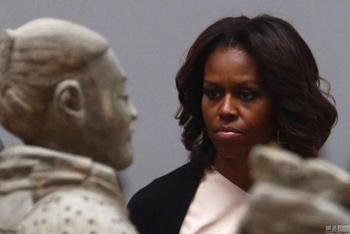 size
terracotta figures of warriors and
horses arranged in battle formations are
the star features at the museum. They
are replicas of what the imperial guard
should look like in those days of pomp
and vigor. size
terracotta figures of warriors and
horses arranged in battle formations are
the star features at the museum. They
are replicas of what the imperial guard
should look like in those days of pomp
and vigor.
The museum is divided into three
sections: No. 1 Pit, No. 2 Pit, and No.
3 Pit respectively. They were tagged in
the order of their discoveries. No. 1
Pit is the largest, first opened to the
public on China's National Day, 1979.
There are columns of soldiers at the
front, followed by war chariots at the
back. No. 2 Pit, found in 1976, contains
over a thousand warriors and 90 chariots
of wood. It was unveiled to the public
in 1994. Archeologists came upon No. 3
Pit also in 1976. It is the command
center of the armed forces. It went on
display in 1989, with 68 warriors, a war
chariot and four horses.
Following our visit with the Terracotta
Warriors, we’ll then step back to an
even earlier time at the Banpo Neolithic
Museum. Located in the eastern outskirts
of Xi’an city, the Banpo Museum is the
first prehistoric excavation site museum
in China. Banpo (half slope) Village was
a typical Neolithic Matriarchal
community of the Yangshao (Respect
Splendid) culture (5000-3000 BC) around
6000 years ago. The Yangshao culture was
named after the first discovery of this
civilization in Yangshao, Henan
Province. About 400 sites of this type
have been discovered around the Yellow
River Basin, and the Banpo site is the
largest one. The site was discovered in
1953 during the construction of a power
plant. The excavation work lasted four
years, and the Banpo site was first
opened to the public in 1958. Since
then, two million people have visited
it.
The Banpo site, occupying an area of
approximately 50,000 square meters, was
divided into three parts: the living
area, the pottery making area and the
cemetery area. Among the ruins are 46
dwellings, two domestic animal pens and
over 200 storage pits, 174 adult tombs,
73 burial jars for kids, six pottery
making kilns and many production and
domestic tools. The site delivers
visitors a vivid picture of the long ago
lifestyle of the primitive Banpo people.
After visiting the Banpo Museum you’ll
be taken to your hotel, the 4 star
Jianguo Hotel, which is just a 15 minute
walk to the old city center.
|
|
| DAY 05 |
Xian-Beijing (by train)
After breakfast we’ll make the short
drive to the Big Wild Goose Pagoda, a
pagoda surrounded by a still functioning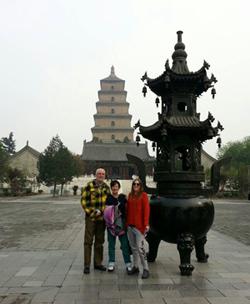 Buddhist temple (named Da Ci’en Temple).
The Big Wild Goose Pagoda is one of the
most famous Buddhist pagodas in China.
The Pagoda was built in the Tang Dynasty
(618-907) for the study of Buddhist
scriptures. Although it has been
attacked by centuries of weather, war
and seismic activity, which destroyed
most of the original material of the
structure, a pagoda by this name and
style still exists on the site. The Tang
regime gave orders to build a chamber
for the translation of Buddhist
scriptures in an effort to have the then
widely renowned Master Xuanzang agree to
be the head of the temple. Xuanzang was
a Buddhist monk who traveled to India,
translated Sanskrit scriptures and
developed theories of consciousness,
karma and rebirth that were adopted by
some later popular schools of Buddhism.
Buddhist temple (named Da Ci’en Temple).
The Big Wild Goose Pagoda is one of the
most famous Buddhist pagodas in China.
The Pagoda was built in the Tang Dynasty
(618-907) for the study of Buddhist
scriptures. Although it has been
attacked by centuries of weather, war
and seismic activity, which destroyed
most of the original material of the
structure, a pagoda by this name and
style still exists on the site. The Tang
regime gave orders to build a chamber
for the translation of Buddhist
scriptures in an effort to have the then
widely renowned Master Xuanzang agree to
be the head of the temple. Xuanzang was
a Buddhist monk who traveled to India,
translated Sanskrit scriptures and
developed theories of consciousness,
karma and rebirth that were adopted by
some later popular schools of Buddhism.
The hallowed pagoda is an architectural
marvel. It was built with layers of
bricks without any cement. The bracket
style used in traditional Chinese
architecture was also used in the
construction of the pagoda. The seams
between each layer of bricks and the "
prisms' on each side of the pagoda are
clearly visible. The grand body of the
pagoda with its solemn appearance,
simple style and high structure, is
indeed a good example of Chinese
traditional architecture.
Then you can unwind a bit by taking a
leisurely stroll on the Xi’an City Wall.
It's the most complete city wall that
has survived in China, as well being one
of the largest ancient military
defensive systems in the world. Xi'an
City Wall was erected in the 14th
century Ming Dynasty, under the regime
of Emperor Zhu Yuanzhang. When Zhu
Yuanzhang captured Huizhou, long before
the establishment of the Ming Dynasty,
he was admonished by a hermit named Zhu
Sheng, who told him to "build high
walls, store abundant provisions and
take your time in proclaiming yourself
emperor." If you like, you have the
option of renting a bike or a rickshaw
on the wall in order to cover more
ground in a shorter time.
In the late afternoon, you’ll be taken
to the train station, where you’ll go on
the overnight train back to Beijing.
Like the train ride to Xian, you’ll stay
in the soft-sleeper compartment.
|
|
| DAY 06 |
Beijing (B, L)
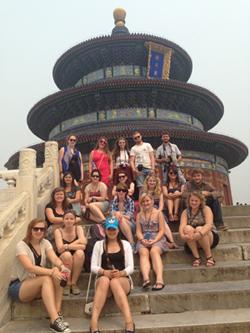
You’ll be back in Beijing by the
morning, and you guide will meet you at
the train station. You’ll be taken back
to the Park Plaza Hotel to freshen up and
unpack, and then we’ll head out to the
Temple of Heaven. The complex was
visited by the Emperors of the Ming and
Qing dynasties for annual ceremonies of
prayer to Heaven for good harvest. The
Temple of Heaven park is best known for
the Hall of Prayer for Good Harvests, an
iconic building famed for its
magnificent triple-gabled circular roof.
You will also have an opportunity to
walk the same imperial walkway that the
same emperors walked hundreds of years
ago in their holy rites. You will also
see Beijing’s senior citizens using the
park grounds for everything from tai chi
and ballroom dancing to bullwhip
practice!
Next you will have the chance to get
some great bargains on clothing at
Xiushui Silk Street. Xiushui Street is one
of the famous clothing markets in
Beijing. It attracts domestic and
foreign tourists with varied styles,
colors and materials as well as an
inexpensive price. Remember to always
haggle, as you can regularly get 50% off
the asking price. If you need some help
your guide is more than happy to help!
|
|
| DAY 07 |
Beijing (B, L)
After breakfast you’ll be able to live
like royalty at the Summer Palace, which
is northwest of the city center. Having
the largest royal park and being well
preserved, the Summer Palace is ranked
amongst the most noted and classical
gardens of the world. In 1998, UNESCO
listed it as one of the World Heritage
Sites. Like most of the gardens of
Beijing, it could not elude the rampages
of the Anglo-French allied force of 1860
and was destroyed by fire. In 1888,
Empress Dowager Cixi embezzled navy
funds to reconstruct it for her own
benefit, changing its name to Summer
Palace (Yiheyuan). She spent most of her
later years there, dealing with state
affairs and entertaining.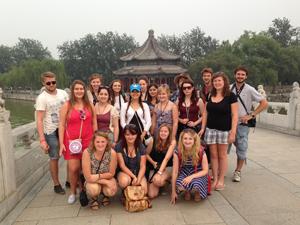
Highlights not to be missed are climbing
Longevity Hill, viewing the Empress
Dowager Cixi’s extravagant Marble Boat,
and talking a walk down Suzhou jie, a
canal meant to resemble the beautiful
river city of Suzhou.
If animals are your passion, then you’re
in luck, because our next stop will be a
visit to the Beijing Zoo. Unlike other
zoos in China, the Beijing Zoo has the
distinct look of a classical Chinese
garden. Initially an imperial manor
during the Ming Dynasty, the grounds was
converted into a zoo in 1908 with the
original name being The Ten Thousand
Animal Garden. The Beijing Zoo exhibits
the wild and rare animals of China.
Outside of traveling to Sichuan, this is
the best place in China to view the
Giant Panda, China’s signature animal.
The zoo also includes a monkey hall,
lion hall, and tiger hall. Altogether
there are more than 30 large halls
exhibiting animals.
You can spend your night walking about
Beijing, as there are numerous clubs,
bars, cafes and markets that will pique
your curiosity.
|
|
| DAY 08 |
Depart Beijing (B)
Following breakfast, you will be driven
to the Beijing airport, where you will
catch your flight to your next
destination, ending your tour with Great
Wall Adventure Club. |
|
|
Package includes:
1.Pickup service
between airport to hotel.
2.The transportation between scenic spots
3.Five nights accommodation based on two persons sharing one standard
room in the four star hotel
4.Soft-sleeper round way train tickets from Beijing to Xi’an.
5.Professional local guide
6.Meals indicated in the itineraries
7.The admission of the first gate |



 . From there we will make
the approximate 2.5 hour drive to the Great Wall at Jinshanling. The Great Wall at Jinshanling is one of the
best preserved parts of the Great Wall with many original
features. It got its name because it was built on the
Greater and Lesser Jinshan (�Gold Mountain�) Ranges. A
tablet with the Chinese inscription for Jinshanling Great
Wall was set into this section. The Jinshanling Great Wall
has not been repaired since 1570. It is a remote and
relatively isolated section of the Great Wall. As there are
relatively few tourists at Jinshanling Great Wall, it is a
good place to explore on foot.
. From there we will make
the approximate 2.5 hour drive to the Great Wall at Jinshanling. The Great Wall at Jinshanling is one of the
best preserved parts of the Great Wall with many original
features. It got its name because it was built on the
Greater and Lesser Jinshan (�Gold Mountain�) Ranges. A
tablet with the Chinese inscription for Jinshanling Great
Wall was set into this section. The Jinshanling Great Wall
has not been repaired since 1570. It is a remote and
relatively isolated section of the Great Wall. As there are
relatively few tourists at Jinshanling Great Wall, it is a
good place to explore on foot.